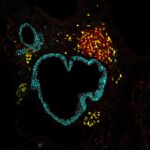
Publication: Distinct ontogenetic lineages dictate cDC2 heterogeneity.
Publié dans: Nat Immunol 2024 Mar; 25(3): 448-461
Auteurs: Minutti CM, Piot C, Pereira da Costa M, Chakravarty P, Rogers N, Huerga Encabo H, Cardoso A, Loong J, Bessou G, Mionnet C, Langhorne J, Bonnet D, Dalod M, Tomasello E, Reis e Sousa C
Résumé
Conventional dendritic cells (cDCs) include functionally and phenotypically diverse populations, such as cDC1s and cDC2s. The latter population has been variously subdivided into Notch-dependent cDC2s, KLF4-dependent cDC2s, T-bet+ cDC2As and T-bet- cDC2Bs, but it is unclear how all these subtypes are interrelated and to what degree they represent cell states or cell subsets. All cDCs are derived from bone marrow progenitors called pre-cDCs, which circulate through the blood to colonize peripheral tissues. Here, we identified distinct mouse pre-cDC2 subsets biased to give rise to cDC2As or cDC2Bs. We showed that a Siglec-H+ pre-cDC2A population in the bone marrow preferentially gave rise to Siglec-H- CD8α+ pre-cDC2As in tissues, which differentiated into T-bet+ cDC2As. In contrast, a Siglec-H- fraction of pre-cDCs in the bone marrow and periphery mostly generated T-bet- cDC2Bs, a lineage marked by the expression of LysM. Our results showed that cDC2A versus cDC2B fate specification starts in the bone marrow and suggest that cDC2 subsets are ontogenetically determined lineages, rather than cell states imposed by the peripheral tissue environment.
Lien vers Pubmed [PMID] – 38351322
Lien vers HAL – hal-04757296
Lien vers le DOI – 10.1038/s41590-024-01745-9

